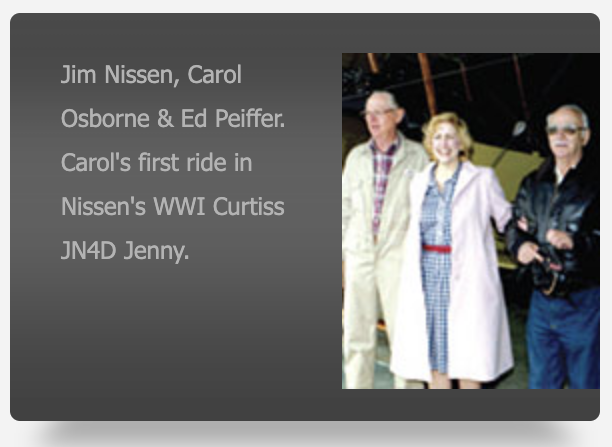Article written by Airport Journals
Carol L. Osborne is a remarkable woman, having dedicated much of her life to recording and preserving aviation history in video, photographs, books and multimedia. Her goal has been to preserve memories and “bring our pioneer aviators back to life on screen.” But not for money, mind you. In fact, there has been no financial compensation.
Carol L. Osborne has invested her life savings, heart and soul in pursuit of honoring these pioneers and providing the world with a priceless collection of aviation history. She said, “It is hard to believe what an impression Prof. David D. Hatfield had on me. He deserves so much more recognition than he has ever received. Hatfield is the one who piqued my interest in aviation history.”

Most of her work has consisted of videotaping pilots, navigators, mechanics, engineers, educators, and anyone with first-hand recollections of the formative years of aviation. Some of the interviews were conducted at the reunions of groups like The Early Birds of Aviation, OX-5 Pioneers, Aero Club of Southern California (SCAA), Roadrunners Internationale (who served out of Area 51), Blackbird Reunion of U-2 pilots, Women Airforce Service Pilots (WASP), etc. Over the past 30 years, she has spent many holidays, weekends and vacations traveling across the country to get these interviews.
She recently started listening to the interviews recorded in the 1980s and 90s as she copied them on to DVDs. It brought so many of these friends back in real time, legendary aviators like Dr. Paul E. Garber, Martin Jensen, P.H. “Spence” Spencer, Capt. Jepp and Nadine Jeppesen, Muriel Earhart Morrissey, Tony LeVier and so many of those interviewed by Osborne who flew west long ago. For Osborne, playing the interviews on screen brought them back to life—it was as if they were telling their stories today.
Her interest in aviation began in late 1970s when she met and became friends with Neta Snook Southern, best known for giving Amelia Earhart her first flight instruction. Southern was one of the first female pilots in the United States, when planes were covered with fabric and dope, and pilots were considered daredevils. Southern started flying during World War I, and after the war, she bought and rebuilt a Canadian training plane (JN4D Jenny). After barnstorming the country, Southern settled in Los Angeles, where she operated a commercial flying field and gave lessons. That was where, in 1921, Southern taught Amelia Earhart how to fly. Fast forward to January 1981—at the request of Zonta International and Donald Douglas, Jr., Osborne accompanied Neta Southern to southern California where she was honored. During this trip, the women visited renowned early aviator, photographer, author, entrepreneur and aviation historian Prof. David D. Hatfield. Hatfield and Jack Northrop co-founded the American Hall of Aviation History (AHAH) at Northrop University in Inglewood, Calif. Although Northrop University campus still exists, its doors were closed in 2003. Many of the historical pieces that were located in the library are now in storage and owned by the Museum of Flight or Osborne. The AHAH library was legendary to aviation and Hollywood.
Prof. Hatfield had a passion for aviation history and had already authored 12 books, from mythology to his “Pioneers of Aviation: A Photo-Biography” series. By the 1980s, Hatfield was producing a series of videotapes called the “History of Flight,” chronicling the subject from ancient times to the exploration of space, all for the purpose of educating young people and future generations. He was amazed with the new technology. When Hatfield passed away at the age of 77, he left behind his aviation history and videotaping equipment to an astonished Carol Osborne. It changed her life.
Then Evelyn “Bobbi” Trout entered the picture. She was a crackerjack pilot who flew to fame in the 1920s and 30s. Because of Trout’s friendship with Hatfield, Osborne met her and soon realized they had something in common—a desire to preserve the history of pioneer aviators. As a result, the women became a team in the effort to capture the stories of surviving aviation pathfinders.
Their “headquarters” was located at Osborne’s home. This is where the legwork was done. Charts were drawn up with the names and addresses of those people they wanted to interview. The Early Birds—a membership of pilots who soloed before the 13th anniversary of the Wright Brothers’ first flight—were first on this list to be interviewed. Lucky few Early Birds received a short briefing about how to control the airplane while they were on the ground. For all the others, they learned the controls intuitively or instinctively. No wonder these briefings became known as a “crash courses.” Unfortunately , Osborne and Trout only captured 14 of the original 598 Early Birds before they were gone forever.
The effort to videotape subjects became a race against the clock. Time is of the essence locating and interviewing pioneers because most of them are in their 80s and 90s. The years flew by, and Osborne and Trout travelled extensively to see as many pioneer stalwarts as possible, for once gone, they’re gone forever.
